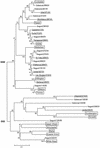Molecular epidemiology of caliciviruses causing outbreaks and sporadic cases of acute gastroenteritis in Spain
- PMID: 12149342
- PMCID: PMC120653
- DOI: 10.1128/JCM.40.8.2854-2859.2002
Molecular epidemiology of caliciviruses causing outbreaks and sporadic cases of acute gastroenteritis in Spain
Abstract
The molecular epidemiology of human caliciviruses (HuCVs) causing sporadic cases and outbreaks of acute gastroenteritis around eastern Spain (Catalonia and the Valencian Community) was studied by reverse transcription-PCR (RT-PCR) and by sequencing part of the RNA polymerase gene in open reading frame 1. HuCVs were detected in 44 of 310 stool specimens (14.19%) negative for other enteric pathogens obtained from children with acute gastroenteritis. Norwalk-like viruses (NLVs) were the most common cause of the gastroenteritis outbreaks investigated here. They were detected in 14 out of 25 (56%) outbreaks with an identified pathogen. Genotypes producing both sporadic cases and outbreaks were diverse, with a predominance of GGII strains related to genotypes Melksham and Lordsdale. Five strains clustered with a "new variant" designated GGIIb, which was detected circulating throughout quite a few European countries in the years 2000 and 2001. The emergence mechanism of these strains might be the occurrence of intertypic recombinations between different viruses. The nucleotide sequence of part of the capsid gene (ORF2) from three of these strains demonstrated their relationship with Mexico virus.
Figures


References
-
- Ando, T., J. S. Noel, and R. L. Fankhauser. 2000. Genetic classification of “Norwalk-like viruses.” J. Infect. Dis. 181:S336-S348. - PubMed
-
- Bon, F., P. Fascia, M. Dauvergne, D. Tenenbaum, H. Planson, A. M. Petion, P. Pothier, and E. Kohli. 1999. Prevalence of group A rotavirus, human calicivirus, astrovirus, and adenovirus type 40 and 41 infections among children with acute gastroenteritis in Dijon, France. J. Clin. Microbiol. 37:3055-3058. - PMC - PubMed
Publication types
MeSH terms
Substances
Associated data
- Actions
- Actions
- Actions
- Actions
- Actions
- Actions
- Actions
- Actions
- Actions
- Actions
- Actions
- Actions
- Actions
- Actions
- Actions
- Actions
- Actions
- Actions
- Actions
- Actions
- Actions
- Actions
- Actions
- Actions
LinkOut - more resources
Full Text Sources
Other Literature Sources
Medical

